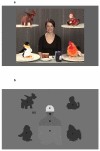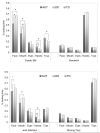Context modulates attention to social scenes in toddlers with autism
- PMID: 22428993
- PMCID: PMC3845814
- DOI: 10.1111/j.1469-7610.2012.02538.x
Context modulates attention to social scenes in toddlers with autism
Abstract
Background: In typical development, the unfolding of social and communicative skills hinges upon the ability to allocate and sustain attention toward people, a skill present moments after birth. Deficits in social attention have been well documented in autism, though the underlying mechanisms are poorly understood.
Methods: In order to parse the factors that are responsible for limited social attention in toddlers with autism, we manipulated the context in which a person appeared in their visual field with regard to the presence of salient social (child-directed speech and eye contact) and nonsocial (distractor toys) cues for attention. Participants included 13- to 25-month-old toddlers with autism (autism; n = 54), developmental delay (DD; n = 22), and typical development (TD; n = 48). Their visual responses were recorded with an eye-tracker.
Results: In conditions devoid of eye contact and speech, the distribution of attention between key features of the social scene in toddlers with autism was comparable to that in DD and TD controls. However, when explicit dyadic cues were introduced, toddlers with autism showed decreased attention to the entire scene and, when they looked at the scene, they spent less time looking at the speaker's face and monitoring her lip movements than the control groups. In toddlers with autism, decreased time spent exploring the entire scene was associated with increased symptom severity and lower nonverbal functioning; atypical language profiles were associated with decreased monitoring of the speaker's face and her mouth.
Conclusions: While in certain contexts toddlers with autism attend to people and objects in a typical manner, they show decreased attentional response to dyadic cues for attention. Given that mechanisms supporting responsivity to dyadic cues are present shortly after birth and are highly consequential for development of social cognition and communication, these findings have important implications for the understanding of the underlying mechanisms of limited social monitoring and identifying pivotal targets for treatment.
© 2012 The Authors. Journal of Child Psychology and Psychiatry © 2012 Association for Child and Adolescent Mental Health.
Figures


References
-
- Adolphs R, Baron-Cohen S, Tranel D. Impaired recognition of social emotions following amygdala damage. Journal of Cognitive Neuroscience. 2002;14(8):1264–1274. - PubMed
-
- Allison T, Puce A, McCarthy G. Social perception from visual cues: Role of the STS region. Trends in Cognitive Sciences. 2000;4(7):267–278. - PubMed
-
- American Psychiatric Association . Diagnostic and statistical manual of mental disorders. 4th ed. Washington: DC: 1994.
-
- Bertone A, Mottron L, Jelenic P, Faubert J. Enhanced and diminished visuo-spatial information processing in autism depends on stimulus complexity. Brain. 2005;128(10):2430–2441. - PubMed
Publication types
MeSH terms
Grants and funding
LinkOut - more resources
Full Text Sources
Other Literature Sources

